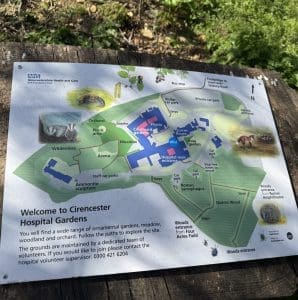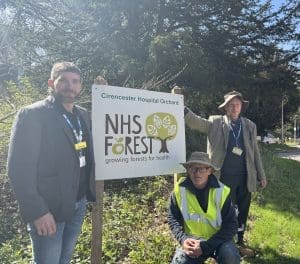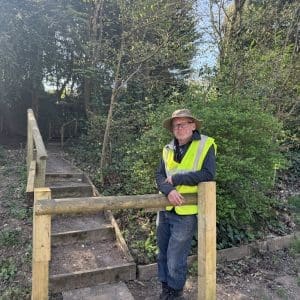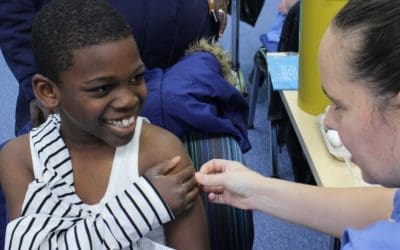The green spaces at three of our community hospital sites are supported by contractors Cotswold Gardens for All CIC, our Estates team and our incredible team of community volunteers.
One project is run by a partnership of a community interest company, Down to Earth and GPs, largely as a veg growing at Vale Community Hospital. This is a social prescribing project, with a separate contract to maintain the gardens.
There are three hospital sites managed by Cotswold Gardens for All Community Interest Company. North Cotswold Community Hospital has a small team of retired keen gardeners. Tewkesbury Hospital has a team of four, some quite experienced gardeners.
Cirencester Hospital is maintained by a large group with a very big range of abilities. These include people with quite severe learning disability, mental health issues, and long term unemployed or retired professionals. The result in all cases has been higher standards in grounds maintenance, social benefits as well as mental and physical benefits for the participants.
The key to the success of the Community Trust projects is the network of local support, with Town Council, doctors, job club, and men in sheds, local schools and colleges, Wildlife Trust, Wildlife in Farming group, all involved.
As our Head of Sustainability James Powell explains, the aim of these spaces is to truly integrate our hospital sites with our surrounding communities:
“Well, I think as a Trust we recognise that not everybody has access to their own garden or green space locally, so it gives people a place to come to come to and join other voluntary group members, social interaction and that kind of thing. It gives them the chance to get outside, work on different types of projects; whether that’s building a garden bench, planters or trees or just maintaining the upkeep of the forest generally. It isn’t just the Cirencester site, the project now manage three sites entirely with volunteers, using the sites as a resource but also integrating the sites with the wider community.”
Cirencester hospital is unique in having so many different areas, from orchard and woodland to a number of courtyards. The grounds have a wide variety of trees and a very wide range of planting developed over many years.
Gardening Volunteer Manager Andre Curtis said: “There’s so much variety on the site – we’ve got a bit of everything really. We’ve got a wonderful team of volunteers and basically, we do what we like with developing the site.
“The playing fields belong to the Town Council, and they took the lease on the Amphitheatre and so they lease the Wood off the NHS. Next to the steps, which cuts the walking distance from a nearby housing estate to the hospital, there are beautifully designed maps of the Querns Wood which were developed and installed by the Council”
 Near the steps, the team have placed an incredibly rare Roman sarcophagus that was found on the site when the MIIU was being developed. As part of the excavation in 1969, the Cirencester Excavation Committee uncovered five sarcophagi in total, which are those in the museum store at the Corinium Museum. Stone sarcophagi date to the 3rd and 4th centuries as inhumation was the main form of burial. Cremation was more common in the 1st and 2nd Centuries. Most inhumations are in graves cut into the ground, occasionally lined with stone. A stone sarcophagus would suggest wealth. Andre added:
Near the steps, the team have placed an incredibly rare Roman sarcophagus that was found on the site when the MIIU was being developed. As part of the excavation in 1969, the Cirencester Excavation Committee uncovered five sarcophagi in total, which are those in the museum store at the Corinium Museum. Stone sarcophagi date to the 3rd and 4th centuries as inhumation was the main form of burial. Cremation was more common in the 1st and 2nd Centuries. Most inhumations are in graves cut into the ground, occasionally lined with stone. A stone sarcophagus would suggest wealth. Andre added:
“The builders left it in a vulnerable place and I was always worried about somebody running into it, so I got some money from St James’s Place Wealth Management to get a specialist contractor to move it, and our volunteers built a shelter over it. We’re told that only 40 have been found of this particular kind of sarcophagus and it was for a high-status individual in what is now known locally as the Bath Gate Cemetery. The cemetery was located in Roman times along the Fosse Way, a Roman road which led to Aqua Sulis (modern day Bath) outside what they called ‘Corinium’ as it was forbidden under Roman law to bury the dead within the walls of the town. The stone sarcophagus is located by car park 1 near the front entrance to the hospital and all other findings are in the centre.
“Some of the paths were built by the Cirencester Offender Management Team. The linking paths from the hospital were built by the hospital garden volunteer team.
The most recent were the steps for a new access to the wood. Work to build the steps to the wood was started the week before the Covid lockdown. That’s one of our major achievements on this site, to link the open spaces together and make walking access to the hospital easier. On top of that, wearing my ‘transport hat’ we got some health promotion money to pay for a walking and cycling map from Cirencester centre. There are paper copies in the hospital entrance and in the town libraries as the council were partners in that project.
The League of Friends gave money for trees along the centre of the site by the connecting road. “The League of Friends are very good, finding money for planting for the site. We’ve always worked in collaboration with the League of Friends; they’re very supportive in helping us across the site. Elsewhere on the site there is a cedar tree. 15 years ago, it was felled and instead of paying to have it taken away on a skip, we paid an artist to sculpt it in the shape of ammonites.
“Some areas we leave untouched as ‘wilderness’ for wildlife. We cut branches and put them into a ‘dead’ hedge’ and that’s good habitat for hedgehogs, birds and insects and we have a badger. There’s so much to the site”. All the green waste that doesn’t go into a dead hedge gets shredded by a contractor.
“Another of our volunteer leaders Kirry Mitchell is a bit of a plant collector, so we’ve got an unusually big range of plants on the site. The joy of this job is looking for opportunities and using what we’ve got.
“We had a problem with the water main where they had all the manholes stuck in the air, so you can’t mow over them, so we put in the garden bed to try and work with it – we find practical solutions.
“Working with my son Fenner Curtis, who is a marketing manager for an opera company, we designed a hospital gardens map of the site using illustrations by Enid Brown and the main features of the grounds. It highlights the key features to be found in grounds and gardens, and we hope it will help visitors and staff to find their way around the green spaces on the site. It’s mainly focussed on walking routes to the hospital. We drew up our plans for a network of paths linking the hospital and all three sites.
“Wherever we’ve worked we’ve tried to promote the idea that we don’t move any soil off-site to cut transport environmentally, and that’s what we’ve done here. I can’t remember which project it was, but there were several lorry-loads of soil and we put it all here to make it possible to do the steps”.
The boundary is the top of the steps – beyond that is the responsibility of the Town Council.
Gardening Volunteer Leader Archie Lelieveld is a trained horticulturist, and he’s got a lot of experience, and his specialism is wildlife and hedge-laying:
“I’ve been doing it for fifteen years probably, so I think I know most people here. And the grounds, although I think Andre knows the grounds a lot better than I do; every single bit of them. We do it once a week, occasionally we have groups come out on different days as well; usually it’s banks – those kind of companies. People that work in an office all day long, they love coming out here and doing some proper work shall we say – you know, actually get tired from working. They love it and absolutely go for it and get a lot of work done and go home happy and tired; it works really well.
The steps were built around five or six years ago and that was actually quite a big project – they go up from the car park opposite the main entrance to the hospital.
Archie: “That took six volunteers and me five or six days, but it’s worked really well and it’s very well used by staff, school kids who cut through here and up to the college – it gets some good usage.”
Elsewhere on the site, the team have started a tree nursery for their donated plants. “We managed to get some trees for free, that needed a home – so we’ve cleared a space that used to be a vegetable garden for one of the nurses a long time ago and this is the start of a new nursery with 45 oak saplings and a maple. Hopefully we’ll expand it – that would be nice to have a good selection of trees here. We’ll plant them in the wood behind as there is a lot of ash die-back, so we’ll replant that. We don’t have a strict replanting schedule – we’re a little organic for that”.
Inspired? We are always looking for volunteers to join our teams at Cirencester, North Cotswolds and Tewkesbury hospital sites. If you’d like to get involved, get in touch with Andre on: 07960 418459 or contact our volunteer coordinator Richard Hobbs on: Richard.Hobbs@ghc.nhs.uk




